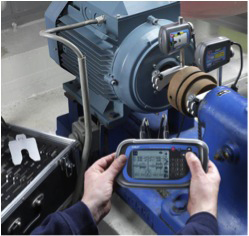Achieving High Reliability in HVAC Rotating Machinery
 Few systems are as critical to hospital operation and patient comfort as HVAC systems, similar to the ones installed by mrquikhomeservices.com/indianapolis/hvac/ac-tune-up/, which are driven by various rotating machines and components including blowers, fans, electric motors, belt drives and bearings. That is why it is essential that they are maintained and checked to ensure they do not fail, for example companies such as https://npmheatingandcooling.com/ac-repair/ may be able to detect a repair or a replacement before it becomes a disaster. Follow the four steps below to improve the reliability and life expectancy of these key machines and components.
Few systems are as critical to hospital operation and patient comfort as HVAC systems, similar to the ones installed by mrquikhomeservices.com/indianapolis/hvac/ac-tune-up/, which are driven by various rotating machines and components including blowers, fans, electric motors, belt drives and bearings. That is why it is essential that they are maintained and checked to ensure they do not fail, for example companies such as https://npmheatingandcooling.com/ac-repair/ may be able to detect a repair or a replacement before it becomes a disaster. Follow the four steps below to improve the reliability and life expectancy of these key machines and components.
The first step is to review your facility’s maintenance practices and modernize them if necessary. Make sure your maintenance technicians receive training in the proper handling and installation of new HVAC components. Always maintain high cleanliness standards when mounting new components. To help avoid damaging bearings, for example, do not remove them from their packaging until just before installation. You can even contact a HVAC specialist if want quick and easy installation, or if you want to talk about any queries you have. They have to be a reliable service, for example there are many a honest HVAC service in Charlottesville, VA, but you can find a local service too.
Further, eliminate outmoded maintenance practices. These include mounting small bearings or components with makeshift tools such as pipe sections. Installation kits with a variety of impact rings and sleeves are a better solution. The rings and sleeves fit a range of different bearing and component sizes and are designed to transmit mounting force safely and effectively.
Portable induction heaters with energy-conserving features can be used to mount medium-size and larger bearings. Some newer units can heat bearings to the specified temperature in 20 minutes or less.
Better Alignments
Boosting alignment accuracy in coupled machines such as electric motors driving large HVAC blowers is the second step. Manual alignment methods using straightedges are still the norm in many facilities, but they can allow small amounts of shaft misalignment. The result is often energy loss and higher vibration and noise.
Advanced alignment systems with laser sighting can help your facility reduce energy-sapping misalignment. A typical system consists of a hand-held display unit and dual-measuring units that are positioned a few feet apart on the coupled shafts. Each measuring unit emits a laser line, which is detected by the opposing unit. Guided by “live” values appearing on the display unit’s screen, the operator adjusts the shafts vertically and horizontally until the shafts are correctly aligned.
There are also alignment systems for belt-driven machinery. The most accurate systems align the grooves of opposing pulleys rather than their faces and can be used to align pulleys of different sizes and types.
Making Lubrication Automatic
The third step is converting to automatic lubricators where possible. Lubricators supply a regulated flow of grease or oil to one or more machine points. They reduce human error and largely eliminate both under- and over-lubrication.
Recently, a 2,000-bed medical center in Vienna, Austria, improved HVAC fan operation by switching to multipoint automatic lubricators. The hospital had a total of 200 fan applications, which previously were manually lubricated. There were frequent fan bearing failures, however, traced mainly to inadequate lubrication. In addition, manual relubing was time-consuming and required considerable labor.
To find a solution, the hospital implemented a test program involving a limited number of fan applications. Centralized multipoint lubricators were installed, and lubrication quantities and dispense rate were carefully adjusted. The lubricators dispensed grease automatically from a central canister to as many as eight separate lubrication points. The canisters needed replenishment only once every few months.
During the six-month program, the fans equipped with automatic lubrication proved highly reliable. Bearing failures due to undergreasing were prevented in the test fans. Since regular relubing by hand was not needed, the hospital realized significant savings in time and labor costs. Based on these results, a decision was made to expand automatic lubrication to all 200 fan applications.
Noncontact Monitoring
Finally, use noncontact monitoring instruments to assess the health of HVAC rotating machines and prevent breakdowns. The noncontact devices allow maintenance workers to monitor operating machinery while remaining at a safe distance.
Helpful instruments include hand-held stroboscopes, thermal cameras and electric erosion detectors. Stroboscopes detect wear in belt drives remotely while the drives remain running. Thermal cameras identify “hot spots” in operating machinery, alerting maintenance technicians to signs of overheating in motors or fans. Electric erosion detectors sense damaging erosion in operating motors, allowing repairs to be made before failure.
Your maintenance department should possess a mix of monitoring technologies tailored to your facility’s specific needs and machine inventory. Calling a specialist like One Hour Bros, diligent monitoring, together with the other steps outlined here, will help keep your HVAC systems and rotating machines running at top efficiency.
